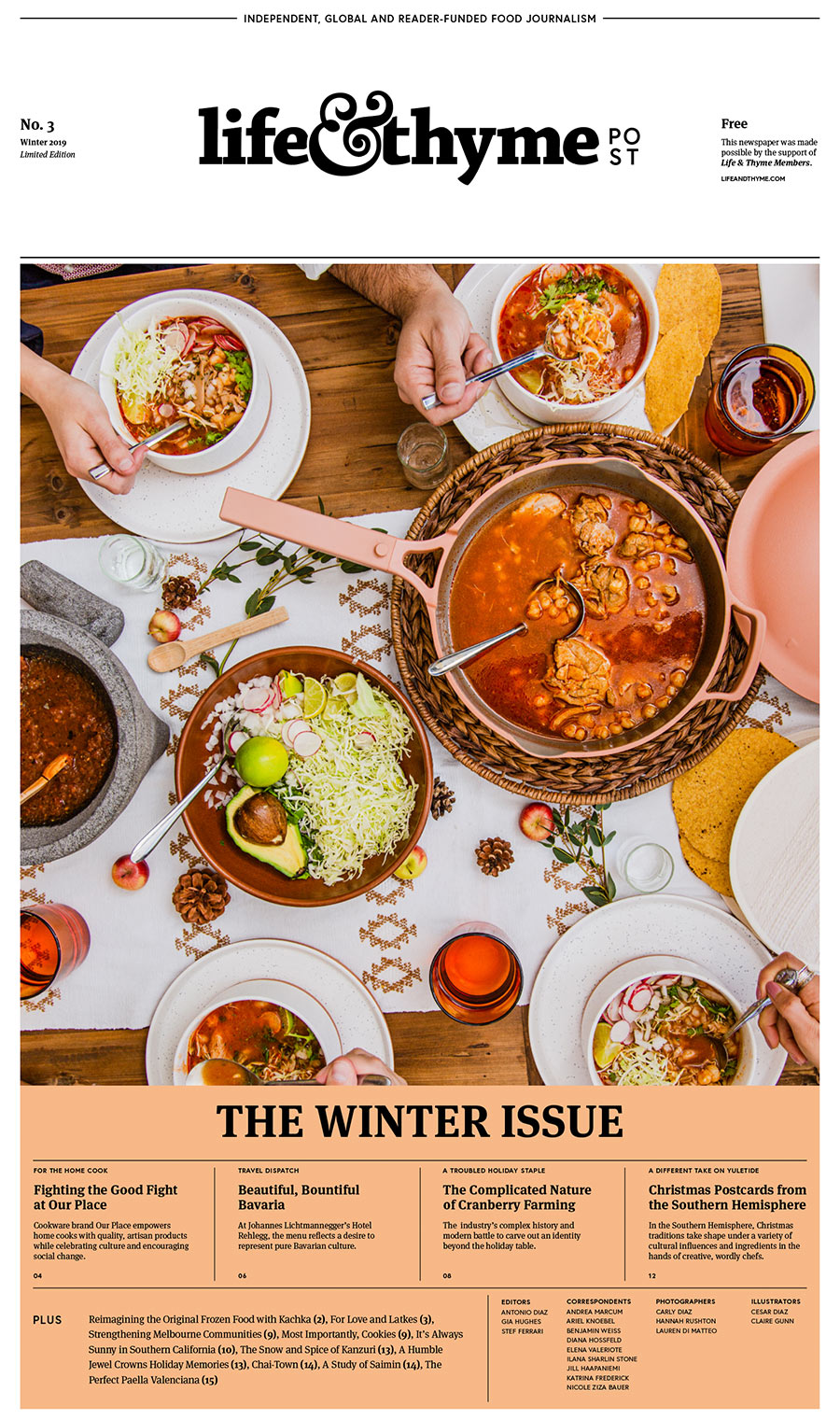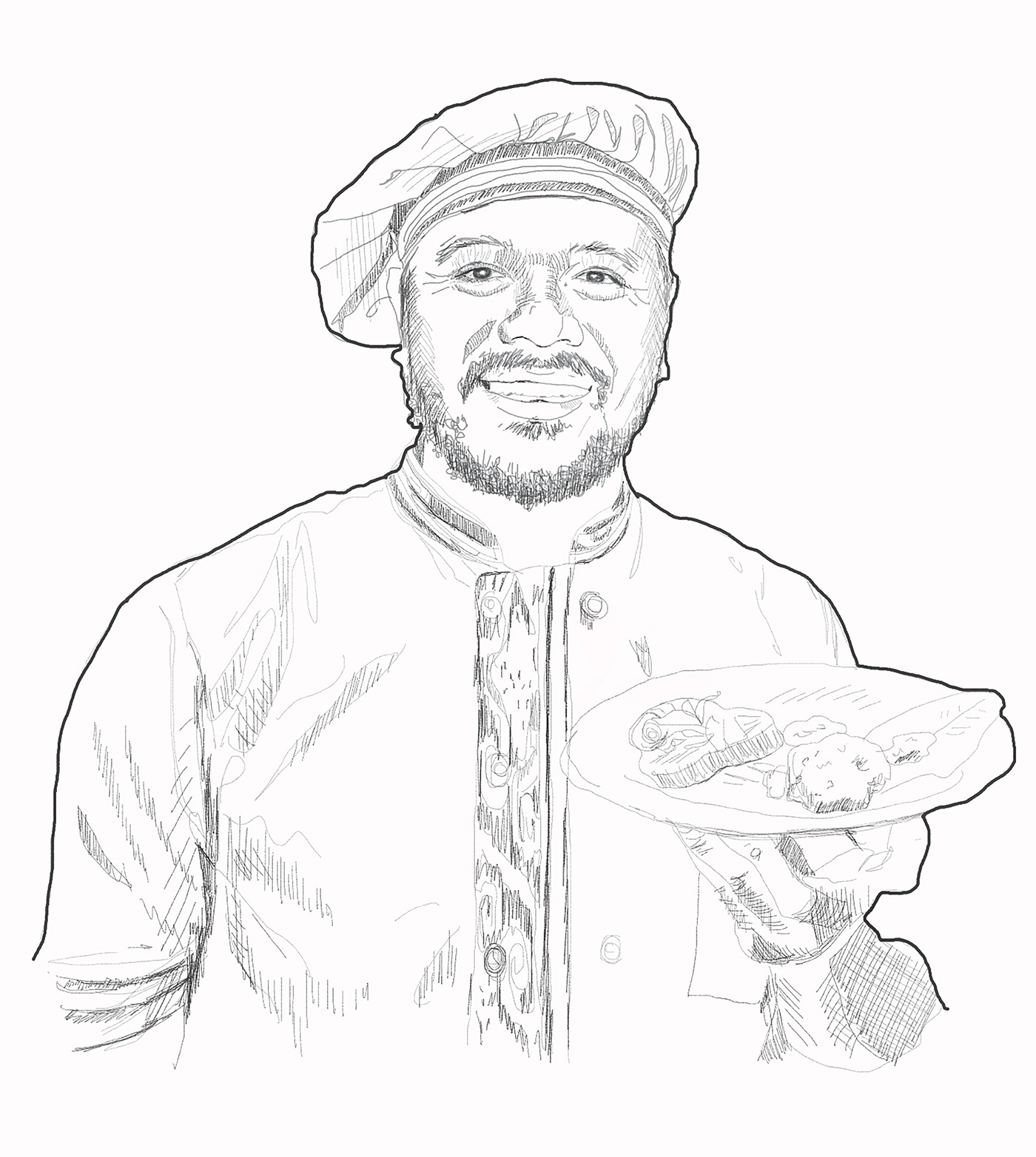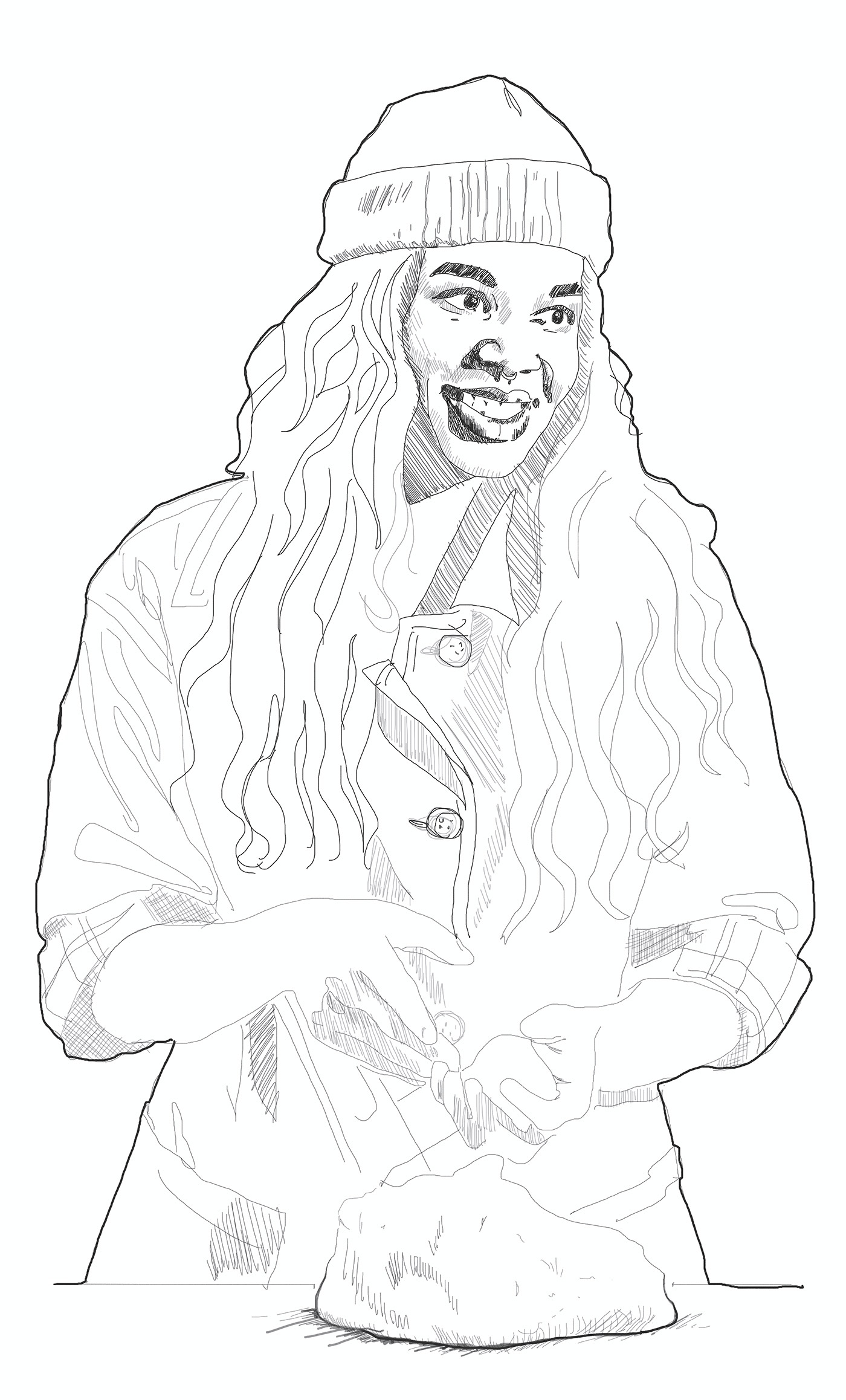
This story can also be found in The Winter Issue of Life & Thyme Post, our limited edition printed newspaper for Life & Thyme members.
Growing up Jewish in Southern California doesn’t make me the ideal spokesperson for wintry Christmas celebrations. More observers than participants, my family did what many L.A. Jewish families did on Christmas Day: we went to the movies and ate Chinese food.
But even the uninitiated can be blown away by her first Southern Hemisphere Christmas, which was with my then newish (non-Jewish) husband’s family in South Africa. At the height of summer. In swimsuits. Eating mince pies next to the pool.
The Southern Hemisphere is home to eight hundred million people—only about ten percent of the world’s population. Colonization is why Christmas is celebrated here, and it’s a word that carries an iron weight of emotional baggage. These countries, such as Brazil, Australia, Timor-Leste, Peru and South Africa, have identities that to various degrees merge their foreign-controlled pasts with the indigenous, as well as the traditions that arrived with non-colonizing immigrants.
What follows are Christmas reflections from five Southern Hemisphere chefs.

Manoella Buffara
Curitiba, Brazil
Manoella (Manu) Buffara is the chef and owner of Manu, one of Brazil’s most highly-rated restaurants located in Curitiba, a city of about two million in the southern state of Paraná.
She has spent every Christmas with her mother’s family; her maternal grandparents emigrated from Lebanon and Italy during World War II (her father’s family is originally Spanish). Since she was a child, her now eighty-five-year-old grandmother cooked virtually the same meal every Christmas.
“Months before, my grandmother would buy the turkey and begin to give it cachaça (a spirit distilled from sugarcane juice) to drink, before killing it,” she says. This is an act of mercy for the turkey, with the bonus of acting as a meat tenderizer for the eater.
“On the one side we have turkey. On the other side: shrimp, whole fish and pork, which my father’s parents bring with them from a port city near Curitiba,” Buffara explains. She describes the feast, which features a whole-baked pig stuffed with pineapple, shrimp and okra stew, and whole-baked fish, often with plantain, and “always eaten with baked sweet potato.” The oven-roasted turkey is served with farofa. “It’s a favorite dish of mine made with toasted manioc flour and the turkey’s innards—like the kidneys and heart—and is eaten cold,” says Buffara.
Before the meal, Buffara’s family shares an emotional prayer giving thanks for the year, being together, and for good health. The evening finishes with a traditional Brazilian fruit dessert: pear, apple or pumpkin, cooked in syrup, along with soft homemade cheese or yogurt ice cream, and panettone—a now entrenched Christmas tradition in Brazil brought by Italian immigrants. “For the kids, my grandma opens one, fills it with vanilla ice cream, and freezes it,” Buffara says.
Her grandmother—who also cooks a large family lunch every Saturday—has a long-time helper in the kitchen, but at Christmas, Buffara is always near. “I believe it’s very important to learn from my grandmother about food and the importance of how you use your hands. Sometimes I think it’s better to listen and not to talk,” Buffara says of the time they spend together. “In the world, everyone wants to talk. But maybe we can learn more by listening.”

Greg Hampton
Melbourne, Australia
For six years, Greg Hampton has been the chef at Charcoal Lane, a Melbourne restaurant that is a social enterprise of Mission Australia. “Our main focus is to connect young aboriginal people to the workforce and to their cultures through food,” explains Hampton, with many of the trainees being the first generation in the workforce. Charcoal Lane is also a showcase for native Australian foods.
Hampton’s early Christmases were in in Hobart, Tasmania, the place he calls “the end of the earth.” His family lived in a close-knit middle-class neighborhood. “Christmas Day started off with my mom putting on a champagne breakfast. People in the street would come, and we’d have some nibbles together,” he says. A hot lunch of roast pork, turkey and traditional vegetables followed, with neighbors rotating as hosts each year.
It was traditional English fare. Hampton’s parents are third generation Australian, and his great-grandparents from Scotland and England. His mother made Christmas puddings always with a coin in the center for luck.
As Hampton has grown as a chef and looked at what grows naturally in Australia, he’s steered away from the traditional English-style Christmas fare. “It doesn’t make a lot of sense for us to be eating a hot roast lunch when it’s eighty-six degrees Fahrenheit with ninety percent humidity.”
He describes today’s Australian Christmases as more casual, with fewer roasts and baked vegetables, and more cold dishes—especially seafood like prawns and Moreton Bay bugs (small lobsters). Seasonal asparagus, beans, cherries and stone fruits are still found on Christmas tables, although these are not foods native to Australia.
Hampton says if he were to arrange a modern Australian Christmas menu, it would feature dishes like poached banana prawns with mango, rivermint salsa and fresh finger limes; roasted kangaroo fillet basted with pepperberry; and apple and muntrie berry, macadamia nut steam puddings with wattleseed butterscotch and lemon myrtle cream. He believes tastes will change over the next generation, especially as more focus on climate change begins to shape cuisines.

Cesar Gaio
Dili, Timor-Leste
Cesar Gaio, chef and owner of the restaurant Dilicious in Timor-Leste’s seaside capital of Dili, is one of a small but growing group of food entrepreneurs working to ignite pride in Timorese food and drinks.
Timor-Leste was primarily a Portuguese colony from the 1500s until 1975, when it declared independence. Within ten days, it was annexed by Indonesia, after which a long guerilla war ravaged the country.
Gaio grew up in a rural area in the district of Baucau, where his parents farmed vegetables and raised their own animals. While he loves cooking in traditional Timorese clay pots and green bamboo, he says Christmas foods tend to have significant Portuguese influence and are centered around grilled meat. “It was my job to slaughter the animals when Christmas came,” says Gaio, which could be pigeon, duck, chicken, pig or goat. In his family, that holiday lunch was cooked by his mother and aunt and usually featured pig or goat. “While waiting for the big meal, we snack on fresh fruit and fried breadfruit or banana, or a slice of cake with local Timorese coffee,” he recalls the traditions of the day. Christmas meals were sometimes exchanged with their closest neighbor, and could be the same meat prepared in a different way. This could be grilled beef or goat with tamarind sauce, or pigeon grilled or stewed with potatoes, tomatoes and carrots.
At the heart of Gaio’s Christmas and integral to Timorese cuisine is breadfruit. “Every house here is a kingdom of breadfruit. In Bacau, it’s the food that is always available and there when we need it,” he says. Gaio takes this ingredient wherever he travels, “to America, Macau, Sweden; it’s a part of me.”
Breadfruit, which is abundant in December, is ubiquitous at Christmas when it is always served in a braise. Gaio says, “It also appears in soups, side dishes, and watercress salad.” Because of Portuguese side dishes like cujido—a mix of boiled potato, carrots and cabbage garnished with tomato and olive oil—Gaio refers to the meal as Portuguese-Timorese fusion.
He also notes he serves an egg pudding made with Timorese coffee liqueur, condensed milk, and eggs, served with Indonesian agar agar. Fruit salad is still the favorite local dessert, even at Christmas. “We didn’t know about sweet stuff until the Portuguese introduced it to Timor,” says Gaio.

André Patsias
Lima, Peru
Born and raised in Lima, André Patsias is the chef at Statera, a fine dining restaurant where sophisticated dishes celebrate Peru’s rich mix of climates and terrains. Pastias is third-generation Greek, and while his family keeps Greek traditions at other times of the year, Christmas at his family home is distinctly Peruvian, and specifically, he says, Lima-style.
“I was raised in a family full of traditions, and we have a lot of respect for Christmas,” says Patsias. He tells me there is a lot of play and anticipation around food reserved for Christmas, and preparations can stretch for weeks in advance.
Turkey is central to Patsias’ Christmas Eve dinner. While enjoyed year-round in Peru, having turkey for Christmas seems to be a tradition that only goes back seventy to eighty years, according to Peruvian journalist Javier Masías, who suggests it may have been spurred by U.S. holiday consumption of the bird. Pastias brines and roasts local turkeys that are stuffed with pineapple, papaya and pear. They’re accompanied by gravy, apple and strawberry purées, and an avocado and pineapple salad in milk mayonnaise.
Roasted baby suckling pig is also served at the table, with whole caramelized apples cooked with pisco and cane sugar. “It’s so soft that we cut it with a plate rather than a knife,” says Patsias. He describes his mom’s Arab rice with affection. “Made with garlic, chicken stock and Coca Cola, raisins, fried noodles, pecans and smoked bacon, it’s savory, sweet, salty and smoky,” he says, referring to it as a house favorite.
Panetón, which made its way to Peru via Italian immigrants but is now baked locally, is the star of dessert. It is always served with butter and hot chocolate—condensed milk mixed with dark chocolate, cinnamon, and a little orange zest. “In my house at least, we only eat panetón two days a year,” says Patsias.
An epic Christmas morning breakfast features leftover turkey along with corn tamales wrapped in banana leaves and pork chicharrónes, with fried sweet potatoes and salsa criolla, a Creole sauce of onions, tomatoes and chillies. More panetón and hot chocolate will follow.
Patsias tells me how important it is for his family to observe these traditions. “It is sacred for my mom and my father,” he says. “Even as a chef, [I] can never change it.”

Khanya Mzongwana
Johannesburg, South Africa
South African chef Khanya Mzongwana is a culinary impresario, fusing cuisines and exciting senses with pop-up experiences in Johannesburg and Pretoria. Her current series, No Rules Cafeteria, is a mix of creative food activation spaces around Johannesburg that blend food, local art and music.
“Christmas is the least traditional Black thing that has ever happened in the world.” This is Mzongwana’s explanation for why, at least at her family Christmases, there were no traditional African foods. She believes that for many families Christmas is, “the opportunity to move away from those usual weekday foods. It’s for splashing out, doing more extravagant things than usual.” Growing up in a Black middle-class family, a huge Christmas Day meal was the norm.
It’s always been a summertime meal based around a braai (barbeque) at her grandmother’s home in New Brighton, a Black township on the outskirts of Port Elizabeth, and featured her mother’s favorite, lamb chops. “My gran, when she was alive, would make her famous frikkadel meatballs. There’s always a big roast and something stewed, for the sake of having gravy,” says Mzongwana.
These days, Mzongwana often cooks the entire meal. She incorporates more fresh produce and likes giving familiar foods a worldly spin. She talks of her savory rice, a mainstay of the feast. “It started out as that rice colored with turmeric with frozen [vegetables] mixed in,” she says. Along with her family, it’s evolved, and in 2017, it was tabbouleh.
They end the meal with what Mzongwana says is a spread of “unrelated desserts,” but there’s always a trifle, a vestige of English colonialism permanently entrenched in South African culture.
As a kid, what Mzongwana loved about Christmas is what she dislikes the most today: the sheer magnitude of it all. But, she also sees the flipside to this abundance.
“When we prepare for Christmas, we prepare for the days to follow,” she says. “It’s the last big meal we cook for the rest of the year.” She tells me the meal is often shared with the community, and that there is a feeling that “it is not just about us, not just about today.”







Our comments section is for members only.
Join today to gain exclusive access.